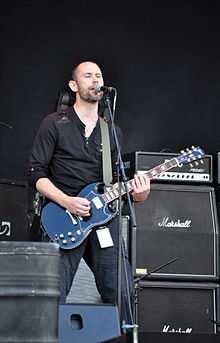Skálmöld
| Skálmöld | |
|---|---|
 Skálmöld at Party.San Open Air 2012 | |
| Background information | |
| Origin | Reykjavík, Iceland |
| Genres | Viking metal, folk metal |
| Years active | 2009–present |
| Labels |
Tutl Napalm Records |
| Associated acts | Innvortis, Sólstafir |
| Website | http://www.skalmold.is/ |
| Members |
Björgvin Sigurðsson Baldur Ragnarsson Snæbjörn Ragnarsson Þráinn Árni Baldvinsson Gunnar Ben Jón Geir Jóhannsson |
Skálmöld (pronounced ['ska͡ulmœlt])[1] is a Viking / folk metal band from Reykjavík, Iceland, formed in August 2009.[2] The band's name is literally translated as Age of Swords and also means "lawlessness", referring to the Sturlung Era of Icelandic history, when a civil war broke out between the country's family clans.[3]
Biography

Snæbjörn Ragnarsson and Björgvin Sigurðsson, who have been friends since childhood and have played together in various collectives, including death metal and punk bands, decided to start a new metal band, Skálmöld, formed in August 2009 in Reykjavík.[4] The other band members had also been active in the Icelandic music scene. Initially, the band was intended to be merely a hobby, but the members soon decided to record an album before they were "too old and tired".[5] After contacting most of the Icelandic labels—to no avail—the band was signed by the Faroese label Tutl in November 2010, which released the band's debut album Baldur in Iceland and the Faroe Islands. In April 2011, the band signed a record deal with Napalm Records; Baldur was re-released worldwide the following August.[6]
The deal with Napalm gave Skálmöld a significant popularity boost. The band was invited to participate in the Wacken Open Air festival and the Heidenfest 2011 tour.[5]
On April 13, 2012, Skálmöld began recording its second album, Börn Loka, which was released at October the same year.[7]
In November, 2013, Skálmöld played a series of concerts with the Iceland Symphony Orchestra at the Harpa concert hall in Reykjavík. A live album and accompanying video was released on December 17, 2013.
Musical style
From the beginning, Skálmöld's intention has been to combine the sounds of the traditional Icelandic music and metal.[4] Initially, the band planned to use a lot of folk instruments, but soon decided to scale back and have three guitar players instead. The band's influences include such metal bands as Metallica, Iron Maiden, Anthrax, Slayer, Amon Amarth and Ensiferum, as well as Jón Leifs, the classical Icelandic composer.[4][8] Skálmöld's lyrics, written by Snæbjörn entirely in Icelandic, are inspired by the Norse mythology and Icelandic sagas.[2] Furthermore, the lyrics conform to some of the Old Norse poetic forms, including fornyrðislag and sléttubönd. [9][10]
Discography
Albums
Singles
- 2013: "Innrás"
Members
- Björgvin Sigurðsson – vocals, guitar
- Baldur Ragnarsson – guitar, vocals
- Snæbjörn Ragnarsson – bass
- Þráinn Árni Baldvinsson – guitar
- Gunnar Ben – keyboards, oboe, vocals
- Jón Geir Jóhannsson – drums, vocals
Gallery
-

Þráinn Árni Baldvinsson
-

Snæbjörn Ragnarsson
-

Jón Geir Jóhannsson
-

Gunnar Ben
-

Baldur Ragnarsson
-
.jpg)
Skálmöld live at the Robin 2, Bilston, Wolverhampton in October 2013.
References
- ↑ http://www.travlang.com/languages/icelandic/Icelandic.pronounce.html
- ↑ 2.0 2.1 Morton, Kenneth (September 1, 2011). "Skálmöld: Grand Viking Metal from Iceland!". Highwire Daze. Retrieved September 11, 2011.
- ↑ "Interview Skálmöld". darkview.be. August 16, 2011. Retrieved September 11, 2011.
- ↑ 4.0 4.1 4.2 "Interview mit Björgvin Sigurðsson zu "Baldur"" (in German). metal.de. December 26, 2010. Retrieved September 11, 2011.
- ↑ 5.0 5.1 "Interview met Skálmöld" (in Dutch). Ashladan. August 13, 2011. Retrieved September 11, 2011.
- ↑ "Skálmöld". Napalm Records. Retrieved September 11, 2011.
- ↑ "Skálmöld taka upp Börn Loka". Morgunblaðið (in Icelandic). April 13, 2012. Retrieved April 13, 2012.
- ↑ "Skálmöld biography". Myspace. Retrieved September 11, 2011.
- ↑ Schmatz, Bastian. "Skálmöld - Baldur" (in German). cdstarts.de. Retrieved September 11, 2011.
- ↑ "Skálmöld - Baldur" (in German). xxl-rock.de. Retrieved September 11, 2011.